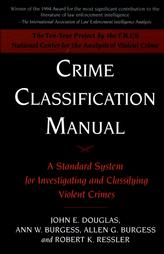Crime Classification Manual
Crime Classification Manual (CCM) is a diagnostic tool developed to standardize the classification of crimes. Its primary purpose is to offer a systematic approach to the categorization of criminal behavior, facilitating the work of law enforcement, forensic psychologists, criminologists, and legal professionals. The manual is akin to the Diagnostic and Statistical Manual of Mental Disorders (DSM) used in the field of psychiatry, but it is specifically tailored for the realm of criminal justice.
Overview[edit | edit source]
The Crime Classification Manual categorizes crimes into three major areas: Crimes Against Persons, Crimes Against Property, and Crimes Against Society. Each category is further subdivided into types and subtypes of crimes, providing a detailed framework for understanding the nature of criminal acts.
Crimes Against Persons[edit | edit source]
This category includes crimes where the direct object of the crime is a person. It encompasses a wide range of criminal behaviors from homicide, assault, kidnapping, and sexual assault, to name a few. Each of these is further broken down. For example, homicide is classified into subcategories such as serial murder, mass murder, and manslaughter, each with its own set of criteria and characteristics.
Crimes Against Property[edit | edit source]
Crimes against property involve the theft or destruction of property. This category includes, but is not limited to, burglary, larceny, arson, and vandalism. Like crimes against persons, these are further divided into more specific types. For instance, burglary is detailed by the circumstances under which it was committed, such as unlawful entry or attempted forcible entry.
Crimes Against Society[edit | edit source]
This classification covers crimes that are primarily against societal norms or governmental regulations rather than against specific individuals or properties. It includes drug-related crimes, gambling, prostitution, and terrorism. These crimes are characterized by their broader impact on the community and society at large.
Development and Usage[edit | edit source]
The Crime Classification Manual was first published in the early 1990s through the collaborative efforts of the Federal Bureau of Investigation (FBI), law enforcement professionals, and forensic experts. Its development was motivated by the need for a unified system that could be used across different jurisdictions and disciplines within the criminal justice system.
The CCM is used by various professionals within the criminal justice system for several purposes, including crime scene analysis, criminal profiling, and the investigation and prosecution of criminal cases. It serves as a guide for identifying patterns of criminal behavior, which can aid in the prediction, prevention, and investigation of crimes.
Editions[edit | edit source]
Since its initial publication, the Crime Classification Manual has undergone revisions and updates to reflect new research, changes in societal norms, and advancements in the understanding of criminal behavior. These updates ensure that the manual remains a relevant and effective tool for professionals in the field.
Criticism and Limitations[edit | edit source]
While the Crime Classification Manual is a valuable resource, it is not without its criticisms. Some argue that the manual can oversimplify the complexity of criminal behavior and the factors that contribute to it. Others point out potential biases in crime classification and the risk of stigmatizing individuals based on the categorization of crimes.
Conclusion[edit | edit source]
The Crime Classification Manual is a cornerstone in the field of criminal justice, providing a structured approach to the classification of crimes. It facilitates communication and collaboration among professionals in the field and contributes to a more systematic understanding of criminal behavior. Despite its limitations, the CCM remains an essential tool for law enforcement, forensic professionals, and criminologists in their ongoing efforts to understand and combat crime.
This article is a criminology-related stub. You can help WikiMD by expanding it!
Search WikiMD
Ad.Tired of being Overweight? Try W8MD's physician weight loss program.
Semaglutide (Ozempic / Wegovy and Tirzepatide (Mounjaro / Zepbound) available.
Advertise on WikiMD
|
WikiMD's Wellness Encyclopedia |
| Let Food Be Thy Medicine Medicine Thy Food - Hippocrates |
Translate this page: - East Asian
中文,
日本,
한국어,
South Asian
हिन्दी,
தமிழ்,
తెలుగు,
Urdu,
ಕನ್ನಡ,
Southeast Asian
Indonesian,
Vietnamese,
Thai,
မြန်မာဘာသာ,
বাংলা
European
español,
Deutsch,
français,
Greek,
português do Brasil,
polski,
română,
русский,
Nederlands,
norsk,
svenska,
suomi,
Italian
Middle Eastern & African
عربى,
Turkish,
Persian,
Hebrew,
Afrikaans,
isiZulu,
Kiswahili,
Other
Bulgarian,
Hungarian,
Czech,
Swedish,
മലയാളം,
मराठी,
ਪੰਜਾਬੀ,
ગુજરાતી,
Portuguese,
Ukrainian
Medical Disclaimer: WikiMD is not a substitute for professional medical advice. The information on WikiMD is provided as an information resource only, may be incorrect, outdated or misleading, and is not to be used or relied on for any diagnostic or treatment purposes. Please consult your health care provider before making any healthcare decisions or for guidance about a specific medical condition. WikiMD expressly disclaims responsibility, and shall have no liability, for any damages, loss, injury, or liability whatsoever suffered as a result of your reliance on the information contained in this site. By visiting this site you agree to the foregoing terms and conditions, which may from time to time be changed or supplemented by WikiMD. If you do not agree to the foregoing terms and conditions, you should not enter or use this site. See full disclaimer.
Credits:Most images are courtesy of Wikimedia commons, and templates, categories Wikipedia, licensed under CC BY SA or similar.
Contributors: Prab R. Tumpati, MD

